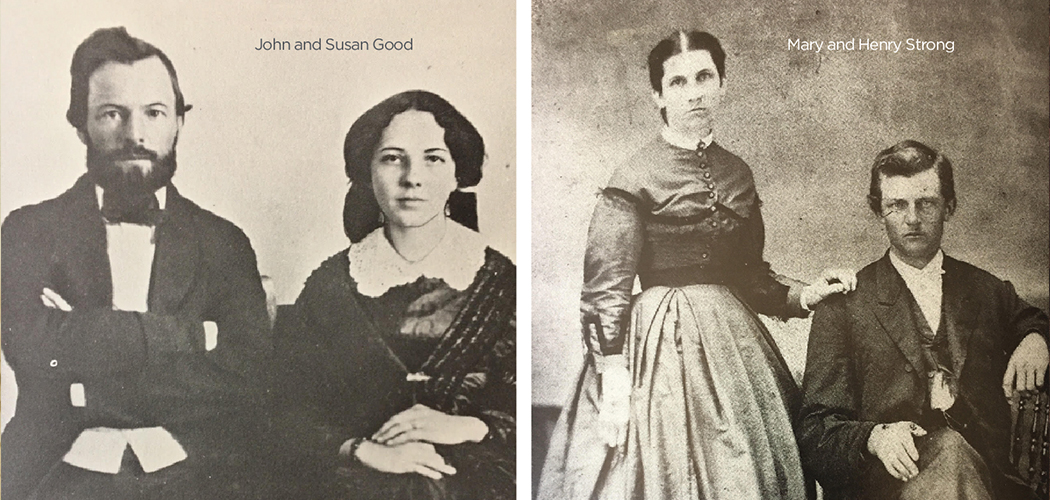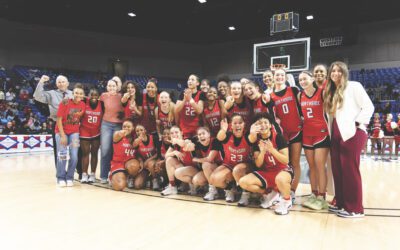[title subtitle=”words: Tom Wing, Historian and Author
images: John and Susan Good (1858), courtesy Hill College, Texas
Mary and Henry Strong (1867), courtesy Carolyn Gleason and Ralph Moody
“][/title]
The Civil War brought soldiers to Fort Smith from various states in the Confederacy and the Union. Fort Smith was occupied at the beginning of the war by Confederate forces, as Arkansas became one of eleven states to leave federal authority. By 1863, Union soldiers had come to Fort Smith, pushing out the Rebels, and stayed till the end of the war and into the reconstruction period that followed. Two soldiers, one gray and the other blue lend insight into those perilous times.
Gray: John J. Good was born in Mississippi, educated in Tennessee, and practiced law in Alabama before seeking his fortune in Texas. He married Susan Floyd and together they had six children. He helped draft the Texas Ordinance of Secession, before being assigned to the Dallas Artillery Battery, which eventually bore his name “Good’s Texas Battery.” In the summer of 1861, Good’s artillerymen and other Texas troops journeyed across the Choctaw Nation to the new Confederate supply and training post established at Fort Smith. Federal troops had abandoned the fort earlier that spring, as Arkansas moved toward secession. John and his wife frequently wrote letters, which were collectively published in 1971.
In August of 1861, Good writes to his wife that on the journey, he and his men witnessed a great war dance of Chickasaw and Choctaw Confederate troops.
In another letter, he describes the town this way: “There are many noble men and patriotic women here, and they are far more attentive to us than can be expected. The ladies have an association. Their president continually sends word not to pay one cent for sewing or washing but to send them everything of the kind. Today, they sent for a list of the sick who ought not to remain in camp and assure me they shall have comfortable rooms in the city and every attention desired. God Bless the women of Fort Smith, who by their many acts of kindness, have charmed the soldier’s heart more than anything since our departure from home. What a pity all our southern women are not of the same stamp. The Dallas Herald should give them praise, not a puff.” Good closes his letter, “Give my love to all, kiss my sons, and accept the love and affection of your husband.”
Good’s Battery was in the center of the action at the Battle of Pea Ridge, in March 1862. Good had a number of his men killed and wounded but escaped injury himself. He survived the war, returned to his wife and children in Texas, and was elected mayor of Dallas in 1880.
Blue: After winning a crucial battle at Honey Springs in Indian Territory, in July 1863, Federal troops arrived to take back Fort Smith in September of that year. In late December, the 12th Kansas Infantry arrived from Fort Scott, Kansas, marching all the way and eventually crossing the frozen Arkansas River at Van Buren on foot. Private Henry A. Strong was one of those Kansas soldiers who, much to his dismay had a “rather rough introduction to this sunny land.” Strong was born in Illinois but raised and educated in Mound City, Kansas. He enlisted in the 12th Kansas Infantry in 1862, and after a few weeks, decided to keep a diary.
In February 1864, Strong got to forget about the war for an evening. He attended “a regular HO DOWN, had a young lady ask me for a chaw of tobacco.”
As part of the 12th Kansas, he helped fortify the perimeter of Fort Smith by digging trenches and building artillery positions. Strong and his regiment participated in battles near Camden later that spring, and in June he and twenty-four others were guarding the steamboat named J.R. Williams, which was headed from Fort Smith to Fort Gibson in the Cherokee Nation. The boat was carrying supplies and food including 16,000 pounds of bacon. Attacked by artillery and overwhelming numbers fifty miles upriver from Fort Smith, Strong, and his fellow soldiers, had to march back to Arkansas. In July 1864, he gave account of the Confederate attack on Fort Smith describing the brave and decisive conduct of the 11th United States Colored Troops, and the 2nd Kansas Battery. Before summer’s end, Strong and the 12th Kansas witnessed the execution of four guerrillas who were caught posing as federal troops.
Through the winter of 1864-65, large numbers of refugees and former slaves displaced by the war, sought help in Fort Smith. On February 23, 1865, Strong “Bade Adieu to Fort Smith, and went scudding down the Arkansas River, the band playing patriotic tunes.” Arriving in Little Rock, he rejoiced at the news of Robert E. Lee’s surrender and was devastated upon hearing of Lincoln’s assassination. In July, the 12th Kansas was sent home. Strong married Mary Madden, had one daughter, and ran a mercantile store in Mound City, Kansas until his death in 1927.
John Good and Henry Strong were only two of the many soldiers from Texas, Louisiana, Missouri, Kansas, Arkansas, Iowa, Illinois, Ohio, and Indian Territory whose lives were not only “touched by the incommunicable experience of war,” but also left a record of those times in Fort Smith.
For further information:
Cannon Smoke: The Letters of Captain John J. Good, Good-Douglas Battery, CSA
Edited by Lester Newton Fitzhugh
1971 Hill College Press
A Rough Introduction to this Sunny Land:
The Civil War Diary of Private Henry A. Strong
Co. K, 12th Kansas Infantry
Edited by Tom Wing
2006 Butler Center for Arkansas Studies




